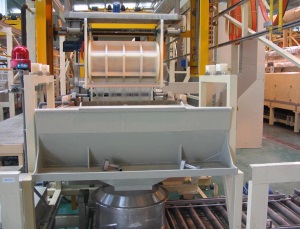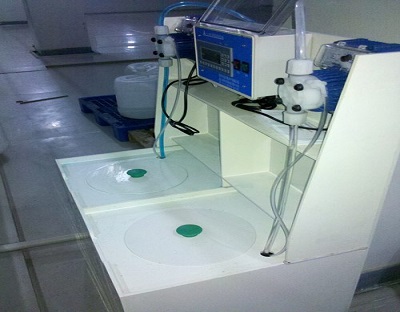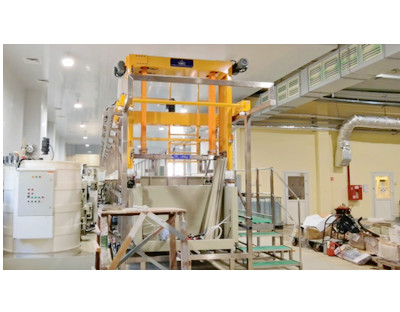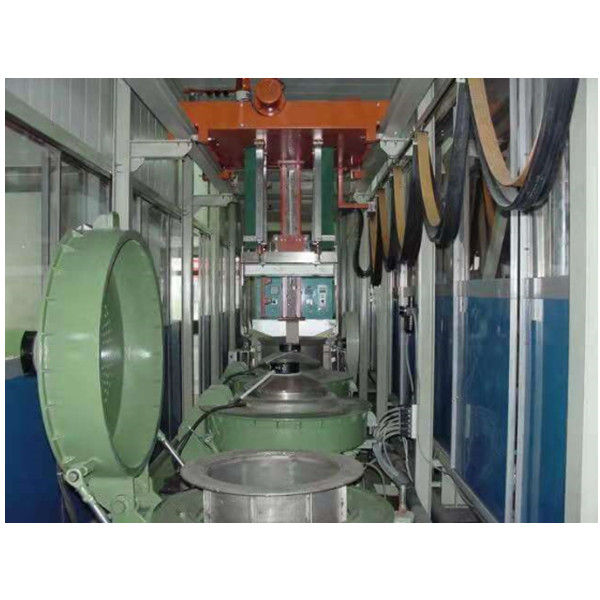1、 Ultrasonic cleaning principle
Ultrasonic cleaning principle: the ultrasonic cleaning machine is used to amplify the electric power of the oscillating signal with a frequency higher than 20kHz through the ultrasonic generator, and then convert it into high-frequency mechanical vibration energy through the inverse piezoelectric effect of the ultrasonic transducer (vibrating head). Through the acoustic radiation in the cleaning medium, the cleaning liquid molecules vibrate and generate numerous tiny bubbles. The bubbles form and grow in the negative pressure area along the ultrasonic propagation direction, and close rapidly in the positive pressure area to generate the instantaneous high pressure of thousands of atmospheres and burst, forming numerous micro high pressure shock waves that act on the surface of the cleaned workpiece. This is the “cavitation effect” in ultrasonic cleaning. Ultrasonic cleaning machine is based on the basic principle of “cavitation effect”. Therefore, ultrasonic cleaning has excellent cleaning ability for workpieces with complex internal and external structures, micro uneven surfaces, slits, small holes, corners, dead corners, and dense components, which is unparalleled by other cleaning methods. With the increase of ultrasonic frequency, the number of bubbles increases and the blasting impact force decreases. Therefore, high-frequency ultrasonic is especially suitable for cleaning small particles of dirt without breaking the surface of the workpiece.
2、 Expansion and bursting of cavitation bubble (implosion)
Bubbles are generated by applying high-frequency (ultrasonic frequency) and high-intensity sound waves to the liquid. Therefore, any ultrasonic cleaning system must have three basic components: a tank containing cleaning liquid, a transducer that converts electrical energy into mechanical energy, and an ultrasonic generator that generates high-frequency electrical signals.
3、 Transducers and generators
Transducer is the most important part of ultrasonic cleaning system. There are two kinds of transducers, one is magnetic transducer, which is made of nickel or nickel alloy; A piezoelectric transducer is made of lead zirconate titanate or other ceramics. When a piezoelectric material is placed in an electric field with varying voltage, it will deform, which is the so-called ‘piezoelectric effect’. In contrast, magnetic transducers are made of materials that can deform in a changing magnetic field. No matter what kind of transducer is used, the most basic factor is the intensity of cavitation effect. Like other sound waves, ultrasonic waves are a series of pressure points, that is, a wave of alternating compression and expansion. If the sound energy is strong enough, the liquid is pushed away in the expansion stage of the wave, thereby generating bubbles; At the compression stage of the wave, these bubbles burst or implode instantaneously in the liquid, generating a very effective impact force, which is especially suitable for cleaning. This process is called cavitation.
4、 Compression and expansion of sound waves
Theoretically, the burst cavitation bubble will generate a pressure of more than 10000psi and a high temperature of 20000 ° f (11000 ° C), and the shock wave will rapidly radiate outward at the moment of its burst. The energy released by a single cavitation bubble is very small, but millions of cavitation bubbles burst at the same time every second, and the cumulative effect will be very strong. The strong impact force will peel off the dirt on the surface of the workpiece, which is the characteristic of all ultrasonic cleaning. If the ultrasonic energy is large enough, cavitation will occur everywhere in the cleaning liquid, so ultrasonic can effectively clean small cracks and holes. Cavitation also promotes the chemical reaction and accelerates the dissolution of the surface facial mask. However, only when the liquid pressure in a certain area is lower than the gas pressure in the bubble will cavitation occur in the area, so this condition can be satisfied when the ultrasonic amplitude generated by the transducer is large enough. The minimum power required to generate cavitation is called cavitation critical point. Different liquids have different cavitation critical points, so the ultrasonic energy must exceed the critical point to achieve the cleaning effect. In other words, only when the energy exceeds the critical point can cavitation bubbles be generated for ultrasonic cleaning.
5、 Importance of frequency
When the working frequency is very low (within the range of human hearing), noise will be generated. When the frequency is lower than 20kHz, the working noise not only becomes large, but also may exceed the safety noise limit specified by the occupational safety and health law or other regulations. In applications that require high power to remove dirt without considering workpiece surface damage, a lower cleaning frequency in the range of 20 kHz to 30 kHz is usually selected. The cleaning frequency in this frequency range is often used to clean large, heavy parts or workpieces of high-density materials.
High frequency is usually used to clean smaller and more precise parts, or to remove small particles. High frequency is also used in applications where the workpiece surface is not allowed to be damaged. Using high frequency can improve cleaning performance in several aspects. With the increase of frequency, the number of cavitation bubbles increases linearly, thus generating more and more dense shock waves that can enter into smaller gaps. If the power remains unchanged, the cavitation bubble becomes smaller, and the energy released by it is correspondingly reduced, thus effectively reducing the damage to the workpiece surface. Another advantage of high frequency is that it reduces the viscous boundary layer (Bernoulli effect), which enables ultrasonic waves to ‘discover’ extremely fine particles. Zzo9 Shenzhen Qiaobo ultrasonic new equipment Co., Ltd. provides a series of frequency products, including 28kHz, 32kHz and 40KHz.
6、 Advantages of ultrasonic cleaning
High precision: because the energy of ultrasonic wave can penetrate fine gaps and small holes, it can be used to clean any parts or assemblies. When the parts to be cleaned are precision parts or assemblies, ultrasonic cleaning is often the only cleaning method that can meet its special technical requirements;
Fast: ultrasonic cleaning is much faster than conventional cleaning methods in dust and scale removal of workpieces. The assembly parts can be cleaned without disassembly. Ultrasonic cleaning has the advantage of saving labor, which often makes it the most economical cleaning method;
Consistency: no matter whether the parts to be cleaned are large or small, simple or complex, single or batch or on the automatic assembly line, the use of ultrasonic cleaning can obtain the unparalleled uniform cleanliness of manual cleaning.
7、 Ultrasonic cleaning technology and selection of cleaning solution
Before purchasing the cleaning system, the following application analysis shall be carried out for the cleaned parts: the material composition, structure and quantity of the cleaned parts shall be determined, and the dirt to be removed shall be analyzed and determined. These are the preconditions for determining the cleaning method to be used and determining whether to use aqueous cleaning solution or solvent. The final cleaning process needs to be verified by cleaning experiments. Only in this way can a suitable cleaning system, a reasonably designed cleaning process and a cleaning solution be provided.
8、 Selection of cleaning fluid
Considering the influence of the physical characteristics of cleaning liquid on ultrasonic cleaning, the steam pressure, surface tension, viscosity and density should be the most significant factors. Temperature can affect these factors, so it also affects the efficiency of cavitation. Any cleaning system must use cleaning fluid.
The following three factors should be considered when selecting cleaning fluid:
1. Cleaning efficiency: when selecting the most effective cleaning solvent, experiments must be done. If ultrasound is introduced into the existing cleaning process, the solvent used generally does not need to be changed;
2. Simple operation: the liquid used shall be safe, non-toxic, easy to operate and long service life;
3. Cost: the use cost of the cheapest cleaning solvent is not necessarily the lowest. The cleaning efficiency and safety of the solvent, the number of workpieces that can be cleaned by a certain amount of solvent and the highest utilization rate must be considered in the use. Of course, the selected cleaning solvent must achieve the cleaning effect and be compatible with the workpiece material to be cleaned. Water is the most common cleaning solution, so the system using water-based solution is easy to operate, low in cost and widely used. However, some materials and dirt are not suitable for aqueous solutions, so there are many solvents to choose from.
9、 Two cleaning systems distinguished by different cleaning solutions
Aqueous system: usually composed of an open tank in which the workpiece is immersed. The complex system will be composed of multiple tanks and equipped with circulating filtration system, flushing tank, drying tank and other accessories. Solvent system: most of them are ultrasonic vapor phase degreasing cleaning machines, often equipped with waste liquid continuous recovery devices. Ultrasonic vapor phase oil removal process is completed by an integrated multi tank system composed of solvent evaporation tank and ultrasonic immersion tank. Under the combined action of hot solvent steam and ultrasonic agitation, oil, grease, wax and other dirt dissolved in solvent are removed. After a series of cleaning procedures, the workpiece is hot, clean and dry.
10、 Treatment of cleaning parts
Another consideration of ultrasonic cleaning is the loading and unloading of cleaning parts or the design of tooling for placing cleaning parts. When the cleaning parts are in the ultrasonic cleaning tank, neither the cleaning parts nor the cleaning parts basket shall touch the bottom of the tank. The total cross-sectional area of the cleaning parts shall not exceed 70% of the cross-sectional area of the ultrasonic tank. Rubber and non rigid plastic will absorb ultrasonic energy, so be careful when using such materials for tooling. Special attention shall also be paid to insulated cleaning parts. The efficiency of even the best ultrasonic cleaning system will be greatly reduced if the tooling basket is not designed properly or the workpieces are too heavy. Hooks, shelves, and beakers can be used to support cleaning parts.







 Jul. 28, 2020
Jul. 28, 2020 





